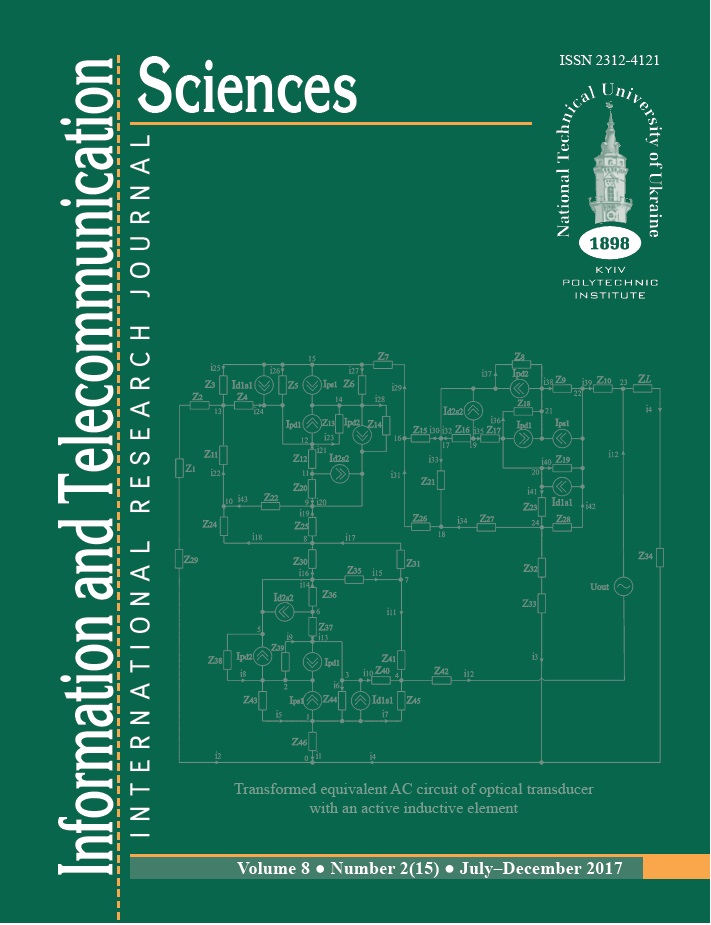OPTICAL FREQUENCY TRANSDUCER BASED ON DUAL-GATE MOSFET WITH AN ACTIVE INDUCTIVE ELEMENT
DOI:
https://doi.org/10.20535/2411-2976.22017.61-68Keywords:
optical transducers, frequency transducers, negative resistance, photoresistor.Abstract
Background. A perspective trend in the development of optical radiation transducers is using of dependencies of reactive properties of semiconductor transistor structures with negative resistance on optical radiation effect and creation of frequency optical radiation transducers on the basis of these properties. Application of optical-frequency transformation enhances noise
stability, accuracy and enables to expand a measuring range, to obtain outputs higher than amplitude ones and to improve metrological performances of the transducers. Using frequency as an informative parameter allows excluding the analog-to-digital transducers during information processing, and reducing the cost of monitoring and control systems. The principle of “optical powerfrequency” transformation can be implemented using semiconductor structure containing self-sustained oscillator and photoresistor as a photosensitive element. Active inductance resolves the problem of low quality factor inherent in the passive inductor. Furthermore, it overcomes compatibility issue of passive inductor's size with the integrated circuit's sizes and allows
completely making transducer as an integrated circuit. So, it is necessary to construct a mathematical model of the optical frequency transducer to analyze its properties and to obtain the dependencies of active and reactive components of the impedance of the semiconductor structure, the equation of sensitivity and the transfer function.
Objective. The aim of the paper is to determine the transfer function and equation of sensitivity for optical transducer with an active inductive element by solving Kirchhoff’s system of equations composed for equivalent circuit of the transducer.
Methods. The determination of the transistor structure impedance was made by solving the Kirchhoff’s system of equations, composed for equivalent circuit of frequency optical transducer. The characteristics describing dependencies of
reactive and active components of the oscillator’s impedance on optical power were obtained by computer simulation using the MATLAB numerical computing environment.
Results. The mathematical model for description of the properties of frequency optical transducer with an active inductive element was developed. The transform function and relative sensitivity analytical equations were estimated to describe the action of transducer. The values of relative sensitivity are equal to 2 – 11.5 kHz/ μWt/cm2. Accuracy of developed mathematical model is ±5%.
Conclusions. The optical transducer with an active inductive element has a high sensitivity in the range of low values of optical power. It makes possible to measure even low optical signals. Proposed model describes the dependence of the impedance of the transistor structure – which is basic for the transducer – on power of optical radiation.
Keywords: optical transducers; frequency transducers; negative resistance; photoresistor.
References
E. Krioukov, D. J. W. Klunder, A. Driessen, J. Greve, and C. Otto. “Sensor based on an integrated optical microcavity”, Optics Letters. vol. 27, issue 7, 2002, pp. 512-514.
Karri L. Michael, Laura C. Taylor , Sandra L. Schultz and David R. “Walt Randomly Ordered Addressable High-Density Optical Sensor Arrays”, Max Tishler Laboratory for Organic Chemistry, Department of Chemistry, Tufts University, Medford, Massachusetts 02155. Anal. Chem., vol. 70 (7), 1998, pp. 1242– 1248.
Microelectronic sensors of physical quantities. Edited Z.Yu..Hotra. In 3 volumes. - Lvov: League-Press, 2003. Vol.2.
Kwang-Jow Gan, Dong-Shong Liang, Chung-Chih Hsiao, Cher- Shiung Tsai and Yaw-Hwang Chen. Investigation of MOS-NDR Voltage Controlled Ring Oscillator Fabricated by CMOS Process. 2005 IEEE Conference on Electron Devices and Solid- State Circuits, 2005. pp. 825-827. DOI:
1109/EDSSC.2005.1635405
Kwang-Jow Gan, Kuan-Yu Chun, Wen-Kuan Yeh. Design of Dynamic Frequency Divider using Negative Differential Resistance Circuit. International Journal on Recent and Innovation Trends in Computing and Communication. 2015. Volume: 3 Issue: 8. pp.5224-5228.
P.V. Novitsky, V.G. Knoring, V.S. Gutnikov. Digital devices with frequency sensors. -Leningrad: Energy, 1970.
V. S. Osadchuk, O. V. Osadchuk and O. O. Seletska, Radiomeasuring optical converters for microelectronic technology, Monograph: Universum, Vinnytsia, Ukraine, 2013.
J. Núñez, M. J. Avedillo and J. M. Quintana. Bifurcation diagrams in MOS-NDR frequency divider circuits. 2012 19th IEEE International Conference on Electronics, Circuits, and Systems (ICECS 2012), Seville, 2012. pp. 480-483. DOI: 10.1109/ICECS.2012. 6463558
A. V. Osadchuk, Microelectronic frequency transducers based on transistor structures with negative resistance, Universum, Vinnytsia, Ukraine, 2000.
D. S. Liang, K. J. Gan and K. Y. Chun. Frequency divider design using the Λ-type negative-differential-resistance circuit. 2010 53rd IEEE International Midwest Symposium on Circuits and Systems, Seattle, WA, 2010. pp. 969-972. DOI: 10.1109/MWSCAS.2010.5548795
V. S. Osadchuk, A.V. Osadchuk, “Radiomeasuring Microelectronic Transducers of Physical Quantities”, IEEE, Proceedings of the International Siberian Conference on Control and Communications (SIBCON), 21-23 May 2015.
Kayatskas A.A. Basics of electronics. Moskow: Executive. wk.,

